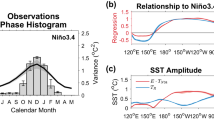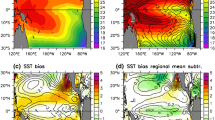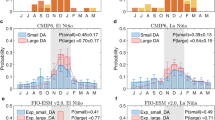Abstract
In this study, the phase-locking of El Nino Southern Oscillation (ENSO) in a coupled model with different physical parameter values is investigated. It is found that there is a dramatic change in ENSO phase-locking in response to a slight change in the Tokioka parameter, which is a minimum entrainment rate threshold in the cumulus parameterization. With a smaller Tokioka parameter, the model simulates ENSO peak in the boreal summer season rather than in the winter season as observed. It is revealed that the differences in climatological zonal sea surface temperature (SST) gradient and its associated mean state changes are crucial to determine the phase-locking of ENSO. In the simulations with smaller Tokioka parameter values, climatological zonal SST gradient during the boreal summer is excessively large, because the zonally-asymmetric SST change (i.e., SST increase is relatively smaller over the eastern Pacific) is maximum during the boreal summer when the eastern Pacific SST is the coolest of the year. The enhanced climatological zonal SST gradient in boreal summer reduces the convection over the eastern Pacific, which leads to a weakening of air–sea coupling strength. The minimum coupling strength during summer prevents SST anomalies from further development in the following season, which favors SST maximum during summer. In addition, enhanced zonal SST gradient and resultant thermocline shoaling over the eastern Pacific lead to excessive zonal advective feedback and thermocline feedback. Atmospheric damping is also weakened during boreal summer season. These changes due to feedback processes allow an excessive development of SST anomalies during the summer time, and lead to a summer peak of ENSO. The importance of basic state change for the ENSO phase-locking is also validated in a multi-model framework using the Coupled Model Intercomparison Project phase-3 archive. It is found that several of the climate models have the same problem in producing a summer peak of ENSO. Consistent with the simulations with different physical parameter values, these models have minimum air–sea coupling strength during the boreal summer season. Also, they have stronger climatological zonal SST gradient and shallower climatological thermocline depth over the eastern Pacific during the boreal summer season.












Similar content being viewed by others
References
An S-I, Jin F-F (2001) Collective role of thermocline and zonal advective feedbacks in the ENSO mode. J Clim 14:3421–3432
An S-I, Wang B (2001) Mechanisms of locking the El Nino and La Nina mature phases to boreal winter. J Clim 14:2164–2176
An S-I, Jin F-F, Kang I-S (1999) The role of zonal advection feedback in phase transition and growth of ENSO in the Cane-Zebiak model. J Meteor Soc Jpn 77:1151–1160
An S-I, Ham Y-G, Kug J-S, Timmermann A, Choi J, Kang I-S (2010) The inverse effect of annual-mean state and annual-cycle changes on ENSO. J Clim 23:1095–1110
Battisti DS (1988) The dynamics and thermodynamics of a warming event in a coupled tropical atmosphere–ocean model. J Atmos Sci 45:2889–2919
Behringer DW, Xue Y (2004) Evaluation of the global ocean data assimilation system at NCEP: the Pacific Ocean. Eighth symposium on integrated observing and assimilation systems for atmosphere, ocean and land surface, AMS 84th annual meeting, Washington State Convention and Trade Center, Seattle, Washington, pp 11–15
Bejarano L, Jin FF (2008) Coexistence of equatorial coupled modes of ENSO. J Clim 21:3051–3067
Cane MA, Munnich M, Zebiak SE (1990) A study of self-excited oscillations of the tropical ocean–atmosphere system. Part I: linear analysis. J Atmos Sci 47:1562–1577
Chang P, Wang B, Li T, Ji L (1994) Interactions between the seasonal cycle and the southern oscillation—Frequency entrainment and chaos in a coupled ocean–atmosphere model. Geophys Res Lett 21:2817–2820
Choi J, An S-I, Kug J-S, Yeh S-W (2011) The role of mean state on changes in El Nino’s flavors. Clim Dyn 37:1205–1215
Collins M et al (2010) The impact of global warming on the tropical Pacific Ocean and El Niño. Nat Geosci 3:391–397
Delworth TL et al (2006) GFDL’s CM2 global coupled climate models. Part I: formulation and simulation characteristics. J Clim 19:634–674
Galanti E, Tziperman E (2000) ENSO’s phase locking to the seasonal cycle in the fast-SST, fast-wave, and mixed-mode regimes. J Atmos Sci 57:2936–2950
Gnanadesikan A et al (2006) GFDL’s CM2 global coupled climate models. Part II: the baseline ocean simulation. J Clim 19:675–697
Graham NE, White WB (1988) The El Nino cycle: a natural oscillator of the Pacific ocean–atmosphere system. Science 240:1293–1302
Griffies SM et al (2005) Formulation of an ocean model for global climate simulations. Ocean Sci 1:45–79
Ham Y-G, Kug J-S (2011) How well do current climate models simulate two-types of El Nino? Clim Dyn. doi:10.1007/s00382-011-1157-3
Harrison DE, Vecchi GA (1999) On the termination of El Niño. Geophys Res Lett 26:1593–1596
Jin F-F (1997) An equatorial ocean recharge paradigm for ENSO. Part I: conceptual model. J Atmos Sci 54:811–829
Jin F-F, An S-I (1999) Thermocline and zonal advective feedbacks within the equatorial ocean recharge oscillator model for ENSO. Geophys Res Lett 26:2989–2992
Jin F-F, Neelin D, Ghil M (1994) ENSO on the devil’s staircase. Science 264:70–72
Kang I-S, Kug J-S (2002) El Nino and La Nina SST anomalies: asymmetric characteristics associated with their wind stress anomalies. J Geophys Res 107(D19):4372. doi:10.1029/2001JD000393
Kim D, Jang Y-S, Kim D-H, Kim Y-H, Watanabe M, Jin F-F, Kug J-S (2011) ENSO sensitivity to cumulus entrainment in a coupled GCM. J Geophys Res Atmos 116:D22112. doi:10.1029/2011JD016526
Kug JS, Jin FF, An SI (2009) Two types of El Niño events: cold tongue El Nino and warm pool El Nino. J Clim 22:1499–1515
Lloyd J, Guilyardi E, Weller H, Slingo J (2009) The role of atmosphere feedbacks during ENSO in the CMIP3 models. Atmos Sci Lett 10:170–176
Neelin JD, Jin F-F, Syu H-H (2000) Variations in ENSO phase locking. J Clim 13:2570–2590
Philander SG (1983) El Nino–Southern Oscillation phenomena. Nature 302:295–301
Philander SG, Yamagata T, Pacanowski RC (1984) Unstable air–sea interactions in the tropics. J Atmos Sci 41:604–613
Rasmusson EM, Carpenter TH (1982) Variations in tropical sea surface temperature and surface wind fields associated with the Southern Oscillation/El Nino. Mon Weather Rev 110:354–384
Rienecker MM et al (2011) MERRA—NASA’s modern-era retrospective analysis for research and applications. J Clim. doi:10.1175/JCLI-D-11-00015.1
Smith T, Reynolds R (2004) Improved extended reconstruction of SST (1854–1997). J Clim 17:2466–2477
Suarez MJ, Schopf PS (1988) A delayed action oscillator for ENSO. J Atmos Sci 45:3283–3287
Tokioka T, Yamazaki K, Kitoh A, Ose T (1988) The equatorial 30–60 day oscillation and the Arakawa-Schubert penetrative cumulus parameterization. J Meteorol Soc Jpn 66:883–901
Tziperman E, Cane MA, Zebiak S (1995) Irregularity and locking to the seasonal cycle in an ENSO prediction model as explained by the quasi-periodicity route to chaos. J Atmos Sci 52:293–306
Tziperman E, Zebiak SE, Cane MA (1997) Mechanisms of seasonal—ENSO interaction. J Atmos Sci 54:61–71
Tziperman E, Cane MA, Blumenthal B (1998) Locking of El Nino peak time to the end of the calendar year in the delayed oscillator picture of ENSO. J Clim 11:2191–2203
Uppala SM et al (2005) The ERA-40 re-analysis. Q J R Meteorol Soc 131:2961–3012. doi:10.1256/qj.04.176
Vecchi GA, Harrison DE (2000) Tropical Pacific sea surface temperature anomalies, El Niño, and equatorial westerly wind events. J Clim 13:1814–1830
Watanabe M, Chikira M, Imada Y, Kimoto M (2011) Convective control of ENSO simulated in MIROC. J Clim 24:543–562
Wittenberg AT, Rosati A, Lau N-C, Ploshay JJ (2006) GFDL’s CM2 global coupled climate models. Part III: tropical Pacific climate and ENSO. J Clim 19:698–722
Xie S-P (1994) On the genesis of the equatorial annual cycle. J Clim 7:2008–2013
Zebiak SE, Cane MA (1987) A model El Nino-Southern Oscillation. Mon Weather Rev 115:2262–2278
Acknowledgments
This work is supported by a National Research Foundation of Korea grant funded by the Korean Government (MEST; NRF-2009-C1AAA001-2009-0093042). D.K. was supported by NASA grant NNX09AK34G.
Author information
Authors and Affiliations
Corresponding author
Rights and permissions
About this article
Cite this article
Ham, YG., Kug, JS., Kim, D. et al. What controls phase-locking of ENSO to boreal winter in coupled GCMs?. Clim Dyn 40, 1551–1568 (2013). https://doi.org/10.1007/s00382-012-1420-2
Received:
Accepted:
Published:
Issue Date:
DOI: https://doi.org/10.1007/s00382-012-1420-2




